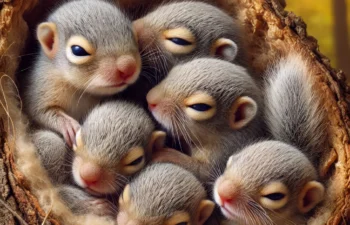
Understanding Squirrel Reproduction in Georgia
If you’ve ever heard scratching noises in your attic or noticed squirrels darting across your roof, you might be dealing with more than just a couple of playful critters—you could have a nest of baby squirrels nearby! As a wildlife removal expert in Georgia, I get calls all the time from homeowners wondering why they suddenly have a squirrel problem. More often than not, it coincides with squirrel birthing seasons. Knowing when squirrels have babies can help you protect your home and take action before a small issue turns into a big problem.
When Do Squirrels Have Babies?
Squirrels in Georgia follow a fairly predictable breeding pattern, with two primary birthing seasons each year. The mild winters and long growing season here make conditions ideal for squirrels to reproduce.
Breeding and Birth Windows
- Winter Breeding Season: Late December – February
- Spring Litters Born: Late February – April
- Summer Breeding Season: Late May – July
- Summer Litters Born: Late July – September
The reason we see two distinct litters is that Georgia’s climate allows squirrels to remain active year-round. Some individual squirrels may even have a third litter if food is abundant and conditions are favorable.
Georgia’s Most Common Squirrel Species
There are three main types of squirrels that Georgia homeowners deal with:
- Eastern Gray Squirrel (most common in suburban areas)
- Fox Squirrel (larger and more common in rural areas)
- Southern Flying Squirrel (smaller and nocturnal, often nesting in attics unnoticed)
Gray squirrels are the most likely to nest in your home, as they are highly adaptable and comfortable living near people.
How to Tell If a Squirrel Has Had Babies Nearby
Even if you don’t see baby squirrels, there are some telltale signs that a mother squirrel has made her nest in or around your home:
- Increased squirrel activity: You may notice more squirrels running along fences and tree branches near your home.
- Chattering or scratching noises: If you hear movement in your attic, chimney, or walls, particularly in the early morning or late evening, a mother squirrel might have moved in.
- Nesting materials: Squirrels use leaves, twigs, and insulation to build nests. If you find these materials scattered near entry points, they may be making themselves at home.
- Frequent entry and exit points: Watch for squirrels repeatedly entering a hole in your roofline or soffits.
A Personal Story: The Attic Surprise
One spring, I got a call from a homeowner in Atlanta who swore she heard “ghosts” in her attic. It turned out to be a mother squirrel with four babies nestled in her insulation! She had entered through a small hole in the eaves, and by the time we found them, the babies were only a few weeks old. This is a perfect example of how important it is to inspect your home for openings before squirrels move in.
Why Squirrels Choose Attics and Homes for Nesting
Squirrels are excellent at finding safe, warm, and hidden places to raise their young. Your attic is an ideal spot because it offers:
- Protection from predators (hawks, owls, snakes).
- Shelter from harsh weather (especially in the unpredictable Georgia spring).
- A warm, insulated environment to help baby squirrels survive.
Many homeowners don’t realize how small of an opening a squirrel needs to squeeze into a home—sometimes just the size of a golf ball!
Risks of Squirrels Nesting in Your Home
While baby squirrels might seem cute, having them inside your home can lead to serious issues. Here’s why you don’t want them hanging around:
1. Property Damage
Squirrels have strong teeth that never stop growing, so they constantly chew to keep them in check. They’ll gnaw on wooden beams, attic insulation, and even plastic pipes.
2. Fire Hazards
One of the biggest risks is squirrels chewing on electrical wires, which can create a major fire hazard. I once removed a nest where the insulation around the wires was nearly stripped bare—one short circuit away from disaster.
3. Health Concerns
Squirrels can carry parasites like fleas and ticks, which could spread into your home. Their urine and droppings also pose health risks if left unaddressed.
4. Increased Activity and Reinfestation
Once squirrels find a safe nesting site, they’ll return year after year unless steps are taken to prevent them. If one litter is born in your attic, chances are high that another will follow.
Humane Squirrel Removal and Prevention Tips
If you suspect a squirrel has made a nest in your home, here’s what you should do:
1. Confirm That Babies Are Present
Squirrel mothers are incredibly protective, and removing a mother without her babies can lead to a stressful (and loud) situation. If removal is necessary, it must be done carefully and humanely.
2. Use One-Way Exit Doors
One of the best ways to remove squirrels is by installing a one-way door. This lets them exit but prevents them from getting back in. However, timing is crucial—if babies are too young, they won’t be able to leave on their own.
3. Seal Entry Points
Once you’re sure the squirrels are gone, seal up any holes with metal flashing or heavy-duty mesh. Avoid using foam or wood, as squirrels can chew right through it.
4. Trim Overhanging Branches
Since squirrels use tree branches to access rooftops, cutting back limbs that hang near your house can make a big difference. Ideally, branches should be at least 8-10 feet from your roof line.
5. Remove Food Sources
Bird feeders, pet food left outside, and unsecured garbage cans attract squirrels. Reducing their access to food can encourage them to nest elsewhere.
6. Call a Professional
If you’re unsure about handling a squirrel infestation, reach out to a professional squirrel removal expert. In Georgia, there are laws protecting certain wildlife, so it’s important to handle the situation legally and ethically.







